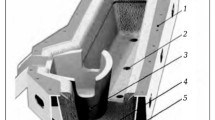Conclusions
Delivery of metal with a closed jet facilitates a big reduction in the quantity of nonmetallic inclusions in the continuously cast ingot.
By examining the kinetic rules governing the reaction of floating inclusions with circulation currents we established the optimum height of the molten steel level in the intermediate ladle as being equal to 600–650 mm.
During the tightening of the nozzle, compounds enriched with alumina (highly dispersed refractory crystalline compounds of the corundum, mullite, and spinel type) are deposited on the walls of the channel.
The higher the metal's concentration of inclusions containing large quantities of Al2O3, then the more intense is their bonding with the refractory, leading to tightening up and growth of the nozzle.
Similar content being viewed by others
Literature cited
Trudy VIO, No. 35, 45 (1963).
V. S. Rutes et al., Ogneupory, No. 4, 4 (1967).
N. M. Frolovskii et al., Ogneupory, No. 3, 17 (1968).
M. G. Chigrinov et al., Metallurg, No. 7, 15 (1968).
V. S. Rutes et al., Ogneupory, No. 7, 37 (1968).
V. S. Rutes et al., Ogneupory, No. 11, 19 (1968).
Author information
Authors and Affiliations
Additional information
Translated from Ogneupory, No. 8, pp. 22–27, August, 1970.
Rights and permissions
About this article
Cite this article
Frolovskii, N.M., Chigrinov, M.G., Askol'dov, V.I. et al. Steel contamination and growths on batching devices for continuous casting. Refractories 11, 486–492 (1970). https://doi.org/10.1007/BF01290733
Issue Date:
DOI: https://doi.org/10.1007/BF01290733




